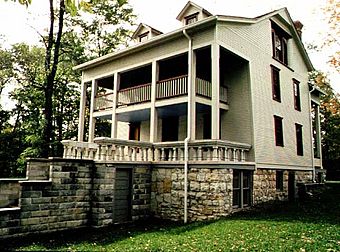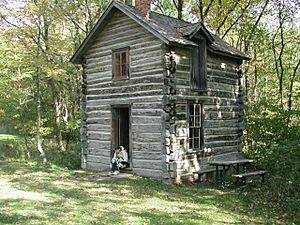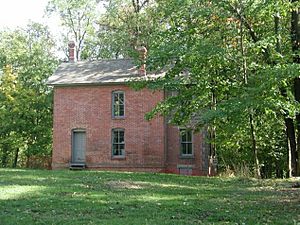Joseph Bailly Homestead facts for kids
|
Joseph Bailley Homestead
|
|

Bailly Homestead: restored back porch, in about 1980
|
|
| Nearest city | Porter, Indiana |
|---|---|
| Built | 1822 |
| NRHP reference No. | 66000005 |
Quick facts for kids Significant dates |
|
| Added to NRHP | October 15, 1966 |
| Designated NHLD | December 29, 1962 |
The Joseph Bailly Homestead, also known as the Joseph Bailly Homestead and Cemetery, is a very old and important place in Porter, Indiana. It's a U.S. National Historic Landmark, which means it's a special place recognized for its history.
The Bailly Homestead is looked after by the National Park Service inside Indiana Dunes National Park. This was the home of Joseph Aubert de Gaspé Bailly de Messein, who was a fur trader, and his family. Joseph Bailly brought his family to the southern shore of Lake Michigan in 1822. The Homestead stayed in his family until his granddaughter, Frances Howe, passed away in 1917. Sometimes, people call it the "Bailly-Howe" Home.
This historic site includes five old buildings and a cemetery. These are all connected to the Bailly-Howe family and the fur trade that happened in northwestern Indiana a long time ago. The Homestead was named a National Historic Landmark in 1962. The National Park Service took over the Homestead on November 26, 1971. Being a Landmark means it's considered very important historically.
The main house is a two-and-a-half-story building. Its construction started in 1834.
Contents
Who Owned the Homestead?
Joseph Bailly bought the Homestead and the land around it in the 1830s. This was when the Calumet area became open for white settlers. When Joseph Bailly died in 1835, his wife inherited the Homestead. After she passed away in 1866, it went to their daughter, Rose Bailly Howe.
Rose Howe's daughter, Frances, inherited the property in 1891 when Rose died. Frances offered the property to a group called the Literary Society of St. Catherine of Sienna in 1914, but they did not accept it. After Frances Howe died in 1917, the property was eventually given to the School Sisters of Notre Dame of the Lake in Milwaukee, Wisconsin in September 1919.
Exploring the Homestead Buildings
Originally, the Homestead had the main house and eight other buildings. These buildings were located to the west of the main driveway. There would also have been stables for horses and carriages.
The Bailly House
Building the main house started just before 1835, the year Joseph Bailly died. This house has two and a half stories. It was built using strong logs of cedar and oak. These logs were carefully fitted together and held with pins at the corners. Later, the outside of the house was covered with overlapping wooden boards.
After Joseph's death, his daughter Ester Bailly Whistler and her family lived in the house. They didn't seem to make any changes. When they moved away, Ester's sister, Rose Bailly Howe, and her family moved in. Rose's husband, Francis Howe, sold timber from the Homestead. This timber was used to build a nearby railroad, where he worked. Francis also updated the house and added a kitchen in the basement. After Francis Howe died, Joel Wicker, the husband of Hortense Bailly Wicker, managed the property. He didn't change the house much.
Before she died, Joseph's widow, Marie Bailly, returned to the Homestead with her daughters, Rose Howe and Teresa, and Rose's two girls. The house needed repairs. Some small repairs were done before Marie passed away. After Marie Bailly's death, the Homestead was empty from 1869 until about 1891. At that time, a lot of work was done to replace floors and walls.
The Dining Room
The Bailly family held Mass (a Catholic church service) in their home for many years. This happened when priests who traveled from place to place (called circuit-riding priests) were passing through. The family and other Catholic people in the area would attend Mass there. It is said that Mass was celebrated using a simple table as an altar, placed in front of the dining room fireplace.
The dining room had special flooring and wooden ceilings and walls. A person named Peter G. Larson put new wood panels in the dining room. He also installed new flooring throughout the house for Mrs. Howe. His work was later repaired. The dining room is on the western side of the first floor of the house. It shares the floor with the living room and a central hallway. The dining room looks much like it did around 1910. A fancy fireplace mantelpiece was carved by Miss Cora Green.
The Living Room
The eastern side of the house is where the living room is located. This room has plaster walls and wooden beams on the ceiling. There is a fireplace in the middle of the east wall.
The earliest descriptions of the living room are from around 1910. It was described as a "pleasant, light and lived-in room." Back then, the ceiling might have been paneled. The fireplace may have been covered with blue and white Delft tiles. Above the mantel, the fireplace was not finished. Margaret Larsen remembered that Rose Howe had a sofa on the inside wall facing the fireplace. There was a tapestry hanging behind the sofa.
The Conservatory
Miss Howe had a conservatory attached to the living room. It was added in 1910. This was a small, rectangular room that was a bit lower than the main floor. It was designed to get a lot of sunlight, probably for plants.
Hall and Porches
A main hallway runs from the front porch to the back porch. The porches stretch across the entire width of the house on both the first and second floors.
Two-Story Log House
The two-story log building north of the Chapel was used by the Bailly family as a dairy house and a tool shed. It is thought that Rose Howe built it after she came back from Europe in 1874. A night-watchman used to live on the ground floor.
The Storehouse
The current storehouse was made from the good logs of an older trading building that Joseph Bailly used. It was originally larger than it is today.
The Chapel or Summer Kitchen
This building was first a two-story kitchen. It's a sad place because Joseph Bailly and his stepdaughter, Theresa de la Vigne, both died here. When Joseph's widow, Marie Bailly, came back in 1855, she chose this building as her home. The outside chimney had fallen down, and the space was closed off. She lived here until she died in 1866.
From 1866 to 1869, Rose Bailly Howe and her daughters, Rose and Frances, held Sunday prayers in this building. Mrs. Howe hired a local carpenter to turn it into a chapel. A new brick foundation was laid, and wood from the kitchen's second floor was used for the chapel floor. The inside was plastered, and the building was finished by 1874. It stayed the same until 1900. At that time, materials from the main house were used for repairs. Materials from the parlor were used because that's where the family had prayed before. This is when the apse (a rounded part of a church) was added. Whitewood from the parlor ceiling was used on the chapel ceiling. The building might have been moved about twenty-five feet to the north.
When the Sisters of Notre Dame used the homestead, they did not use this chapel. Instead, they used a front bedroom on the second floor as their chapel. This building then remained unused until 1946. At that time, the new owners, Mr. and Mrs. Joseph LaRoche, rented it out as a place for people to live. No more changes were made to it.
The Brick House
To the southwest of the main house, you can find the brick house. Miss Rose Howe built it in 1874 after she returned from Europe. Miss Howe died in 1879, which means the house was built about 3 or 4 years before that. The second floor was used as a studio, and the ground floor was used as a kitchen.
The Bailly Cemetery
The cemetery is about three-quarters of a mile north of the main house, on the edge of a sand ridge. The first person recorded as being buried here was Robert, Joseph Bailly's son, around 1827. Since then, it has been known as a family graveyard. Many people who were not part of the Bailly family are also buried there. Today, most of the graves are unmarked, including those of Swedish residents from the area. Outside the main cemetery area to the north, there are eight recorded tombstones. Two of these are older than 1827: Peter Carlbon, 1814; and Thomas B. Speer, 1817.







